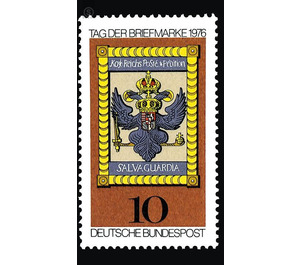day of the stamp - Germany / Federal Republic of Germany 1976 - 10 Pfennig
Theme: Art & Culture
| Country | Germany / Federal Republic of Germany |
| Issue Date | 1976 |
| Face Value | 10.00 |
| Color | brown |
| Perforation | K 14 |
| Printing Type | Six-color offset printing |
| Stamp Type | Postage stamp |
| Item Type | Stamp |
| Chronological Issue Number | 792 |
| Chronological Chapter | GER-BRD |
| SID | 733917 |
| In 62 Wishlists | |
For around 40 years, the "Stamp Day" has been celebrated all over the world. It is a German "invention", which was taken up in 1935 by the World Federation of Collector Associations, the Fédération Internationale de Philatélie (FIP), and made common property. The day of the stamp draws the public's attention, especially the youth, to the diversity and beauty of collecting postage stamps, stamps and post-historical documents. The Deutsche Bundespost supports this endeavor of the Bund Deutscher Philatelisten e.V. (BDPh), the umbrella organization of stamp collectors, for several years with the publication of a Postwertzeichen from the series Posthausschilder. In 1976, the BDPh commemorates the 30th anniversary of its re-establishment after the Second World War. Today, around 800 philatelic clubs are available to stamp collectors in the Federal Republic of Germany for the care of their hobbyhorse. The motif shows the post office sign of the Imperial Reich Postal Expedition Höchst am Main (now district of Frankfurt am Main) from the second half of the 18th century. The shield consists of driven sheet metal and shows the imperial eagle with all attributes. The breastplate, covered with a royal crown, shows the arrangement of its principal coats of arms chosen at the reign of Emperor Joseph II (1765-1790): Old and New Hungary, Bohemia, Burgundy and Tuscany; The applied heart shield is split between Austria and Lorraine and covered with an archduke's hat. The word "SALVAGUARDIA" under the coat of arms corresponds to a letter of protection, which was attached to public buildings in the original, in transcript or in connection with the coat of arms. This authorization dates back to a decree of Emperor Ferdinand II in 1626, which prohibited all persons from occupying post offices, billeting and looting, and harassing postal staff. The original sign is located in the Federal Postal Museum in Frankfurt am Main.


